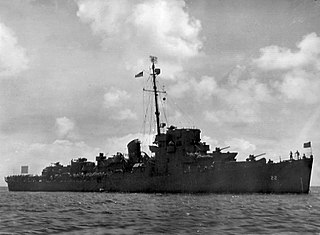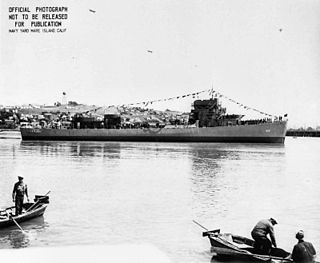
Mahan-class destroyers of the United States Navy were a series of 18 destroyers of which the first 16 were laid down in 1934. The last two of the 18, Dunlap and Fanning, are sometimes considered a separate ship class. All 18 were commissioned in 1936 and 1937. Mahan was the lead ship, named for Rear Admiral Alfred Thayer Mahan, an influential historian and theorist on sea power.

USS Mertz (DD-691) was a Fletcher-class destroyer in the service of the United States Navy from 1943 to 1946. She was scrapped in 1972.

USS Schley (DD-103) was a Wickes-class destroyer in the United States Navy during World War I and later designated, APD-14 in World War II. She was the first ship named in honor of Winfield Scott Schley.

USS Haraden (DD-585), a Fletcher-class destroyer, was the second ship of the United States Navy to be named for Jonathan Haraden (1744–1803), a privateer of the American Revolutionary War.

USS Overton (DD-239/APD–23) was a United States Navy Clemson-class destroyer and high-speed transport that saw service during World War II.

USS Izard (DD-589), a Fletcher-class destroyer, was a ship of the United States Navy named for Lieutenant Ralph Izard (1785–1822),

USS Stevens (DD-479) was a Fletcher-class destroyer in service with the United States Navy from 1943 to 1946. She was finally sold for scrap in 1973.

USS Schroeder (DD-501), a Fletcher-class destroyer, was a ship of the United States Navy, named for Rear Admiral Seaton Schroeder (1849–1922). Entering service in 1943, the ship saw action during World War II, participating in the Battle of Tarawa. Following the war the destroyer was placed in reserve, remaining in this state until 1972. She was sold for scrap in 1974.

USS Acree (DE-167) was a Cannon-class destroyer escort in service the United States Navy from 1943 to 1946. She was scrapped in 1973.

The third USS Macdonough (DD-351) was a Farragut-class destroyer in the United States Navy during World War II. She was named for Thomas Macdonough.

USS McDermut (DD-677) was a Fletcher-class destroyer of the United States Navy, the second Navy ship named for Lieutenant Commander David A. McDermut.

USS Elden (DE-264) was an Evarts-class destroyer escort in the service of the United States Navy.

USS Crouter (DE-11) was an Evarts-class destroyer escort of the United States Navy in commission from 1943 to 1945. The ship was named after Mark Hanna Crouter (1897–1942), U.S. Navy officer and Navy Cross recipient.

USS LeHardy (DE-20) was an Evarts-class destroyer escort constructed for the United States Navy during World War II. It was promptly sent off into the Pacific Ocean to protect convoys and other ships from Japanese submarines and fighter aircraft. At the end of the war, she had the honor of proceeding to Wake Island, as the Japanese commander surrendered, and raising a flagpole to fly the American flag once again.

USS Wileman (DE-22) was an Evarts-class destroyer escort constructed for the United States Navy during World War II. It was promptly sent off into the Pacific Ocean to protect convoys and other ships from Japanese submarines and fighter aircraft. At the end of the war, she returned to the United States proudly displaying four battle stars.

USS Whitman (DE-24) was an Evarts-class destroyer escort constructed for the United States Navy during World War II. It was promptly sent off into the Pacific Ocean to protect convoys and other ships from Japanese submarines and fighter aircraft. By the end of the war, when she returned to the United States, she had accumulated four battle stars.
The second USS Dempsey (DE-26) was an Evarts-class destroyer escort constructed for the United States Navy during World War II. She was promptly sent off into the Pacific Ocean to protect convoys and other ships from Japanese submarines and fighter aircraft. By the end of the ship's World War II service career, when she returned to the United States, she had accumulated three battle stars.

USS Emery (DE-28) was an Evarts-class destroyer escort constructed for the United States Navy during World War II. It was promptly sent off into the Pacific Ocean to protect convoys and other ships from Japanese submarines and fighter aircraft. By the end of the war, she had accumulated three battle stars.

The second USS Tisdale (DE-33) was an Evarts-class destroyer escort of the United States Navy during World War II. She was promptly sent off into the Pacific Ocean to protect convoys and other ships from Japanese submarines and fighter aircraft. She performed dangerous work in numerous battle areas, and was awarded four battle stars.

USS Snyder (DE-745) was a Cannon-class destroyer escort built for the United States Navy during World War II. She served in the Pacific Ocean and provided escort service against submarine and air attack for Navy vessels and convoys.



















